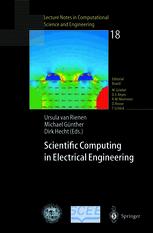

Most ebook files are in PDF format, so you can easily read them using various software such as Foxit Reader or directly on the Google Chrome browser.
Some ebook files are released by publishers in other formats such as .awz, .mobi, .epub, .fb2, etc. You may need to install specific software to read these formats on mobile/PC, such as Calibre.
Please read the tutorial at this link: https://ebookbell.com/faq
We offer FREE conversion to the popular formats you request; however, this may take some time. Therefore, right after payment, please email us, and we will try to provide the service as quickly as possible.
For some exceptional file formats or broken links (if any), please refrain from opening any disputes. Instead, email us first, and we will try to assist within a maximum of 6 hours.
EbookBell Team

4.8
84 reviewsrd This book presents a collection of selected contributions presented at the 3 International Workshop on Scientific Computing in Electrical Engineering, SCEE-2000, which took place in Warnemiinde, Germany, from August 20 to 23, 2000. Nearly hundred scientists and engineers from thirteen countries gathered in Warnemiinde to participate in the conference. Rostock Univer sity, the oldest university in Northern Europe founded in 1419, hosted the conference. This workshop followed two earlier workshops held 1997 at the Darmstadt University of Technology and 1998 at Weierstrass Institute for Applied Anal ysis and Stochastics in Berlin under the auspices ofthe German Mathematical Society. These workshops aimed at bringing together two scientific communi ties: applied mathematicians and electrical engineers who do research in the field of scientific computing in electrical engineering. This, of course, is a wide field, which is why it was decided to concentrate on selected major topics. The workshop in Darmstadt, which was organized by Michael Giinther from the Mathematics Department and Ursula van Rienen from the Department of Electrical Engineering and Information Technology,brought together more than hundred scientists interested in numerical methods for the simulation of circuits and electromagnetic fields. This was a great success. Voices coming from the participants suggested that it was time to bring these communities together in order to get to know each other, to discuss mutual interests and to start cooperative work. A collection of selected contributions appeared in 'Surveys on Mathematics for Industry', Vol.8, No. 3-4 and Vol.9, No.2, 1999.